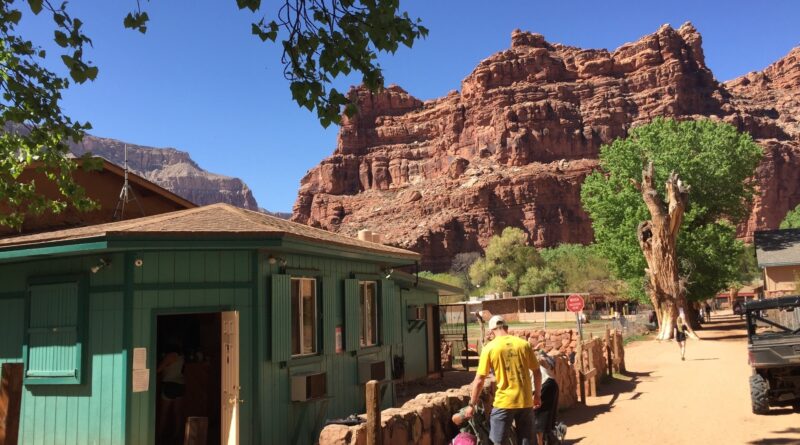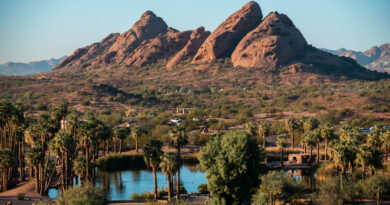Experience the Waterfalls in Supai Arizona
Supai, Arizona, is a remote and stunning destination that has captured the hearts of adventurers, nature lovers, and photographers from around the world. Nestled deep within the Grand Canyon, Supai is home to the Havasupai tribe and is famous for its breathtaking waterfalls, which are among the most beautiful in the United States. These turquoise-blue cascades, surrounded by the rugged red rock landscape of the canyon, create a surreal and enchanting environment that seems almost otherworldly. This article explores the magnificent waterfalls of Supai, Arizona, detailing their history, unique features, and what makes them a must-visit destination for anyone seeking a truly unforgettable natural experience.
The Havasupai Tribe
The Havasupai people, whose name means “people of the blue-green waters,” have lived in the Grand Canyon for over 1,000 years. Supai, their home, is the most remote village in the contiguous United States, accessible only by foot, mule, or helicopter. The Havasupai have a deep spiritual connection to the land and the waterfalls, which play a central role in their culture and way of life. The tribe has worked diligently to preserve their ancestral lands while sharing their natural wonders with visitors from around the globe. Their stewardship of this area ensures that the beauty and purity of the waterfalls are maintained for future generations.
The Journey to Supai
Reaching Supai is an adventure in itself, and there are several ways to access this remote paradise. The most popular method is hiking the 8-mile trail from Hualapai Hilltop to the village of Supai. This trail descends 2,000 feet into the canyon, offering breathtaking views and a challenging yet rewarding experience for hikers. For those who prefer a less strenuous journey, helicopters are available to transport visitors from Hualapai Hilltop to Supai, providing a quick and scenic aerial view of the canyon. Mule trains are also an option, either for transporting gear or for riding into the canyon, offering a more traditional and unique way to reach the village.
Regardless of how you choose to travel, the journey to Supai is part of what makes the experience so special. The sense of remoteness, the awe-inspiring landscape, and the anticipation of seeing the waterfalls create a sense of adventure that is unmatched by more easily accessible destinations.
Havasu Falls

Havasu Falls is undoubtedly the most famous and photographed of the waterfalls in Supai. Its vibrant turquoise-blue waters, set against the red rock walls of the canyon, create a striking and unforgettable contrast. The falls drop about 100 feet into a series of pools, which are perfect for swimming, wading, and simply enjoying the serene beauty of the area.
The unique color of the water is due to the high mineral content, particularly calcium carbonate, which gives the water its distinctive hue. Over the years, the shape of Havasu Falls has changed due to natural erosion and the occasional flash flood, but it remains one of the most iconic natural landmarks in the United States.
Visitors to Havasu Falls often spend hours or even days here, camping nearby and exploring the various pools and cascades. The area around the falls is equipped with basic facilities, including composting toilets and picnic tables, making it a comfortable spot for extended stays. However, the true draw is the chance to disconnect from the modern world and reconnect with nature in one of the most beautiful settings imaginable.
Mooney Falls
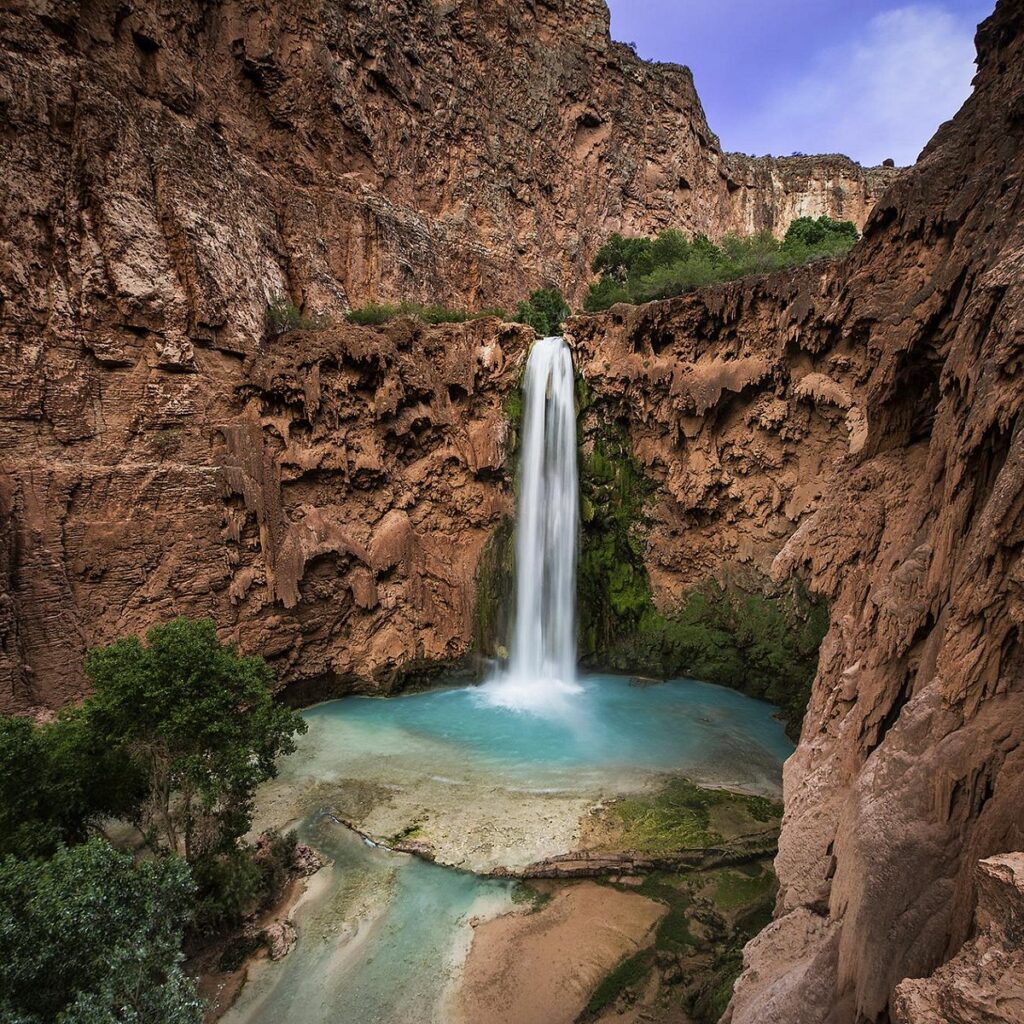
Mooney Falls, the tallest of the waterfalls in Supai, is an awe-inspiring sight that should not be missed. Plunging nearly 200 feet down a sheer cliff face, Mooney Falls is both beautiful and intimidating. Named after D.W. “James” Mooney, a prospector who tragically fell to his death here in the late 19th century, the waterfall is a reminder of the power and unpredictability of nature.
Reaching the base of Mooney Falls is an adventure in itself. The trail leading down to the falls requires a steep descent through a series of tunnels and along a narrow, rocky path equipped with chains and ladders for support. This descent is not for the faint of heart, but those who make the journey are rewarded with an up-close view of the falls and the opportunity to swim in its crystal-clear pools.
The area around Mooney Falls is less crowded than Havasu Falls, providing a more secluded and tranquil experience. The sheer height of the waterfall and the force of the water as it crashes into the pool below create a mesmerizing display that captures the raw beauty of the Grand Canyon.
Beaver Falls
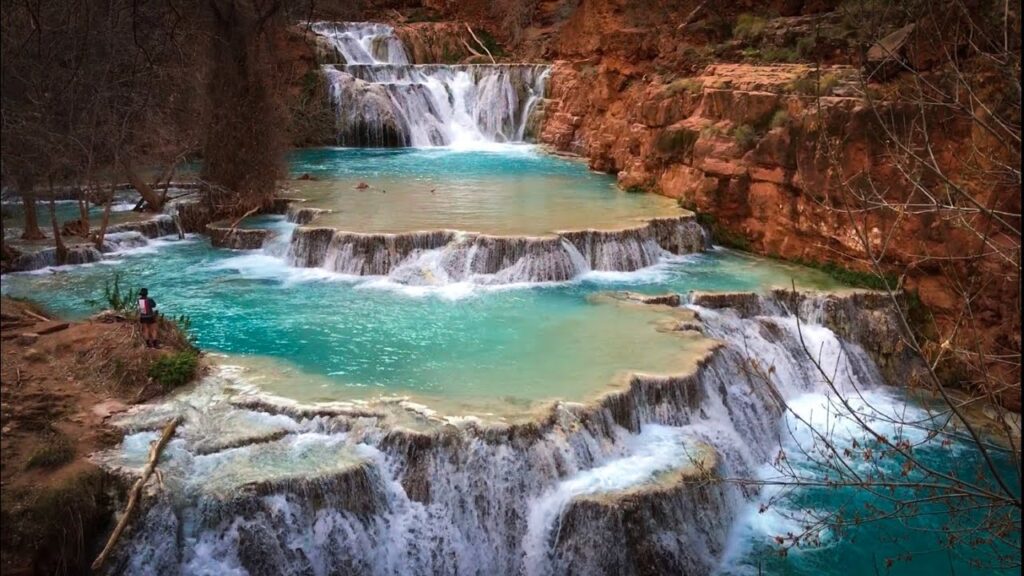
Beaver Falls is a hidden gem in Supai, often overshadowed by the more famous Havasu and Mooney Falls, but it is equally deserving of attention. Located about 3 miles downstream from Mooney Falls, Beaver Falls is a series of smaller cascades that stretch across the Havasu Creek, creating multiple pools and waterfalls in a lush, green setting.
The hike to Beaver Falls is longer and more challenging, involving creek crossings, rock scrambling, and navigating through thick vegetation. However, the journey is well worth it for those who seek a more adventurous and less-crowded destination. The falls are surrounded by greenery, creating a jungle-like atmosphere that contrasts with the arid desert landscape of the canyon above.
Beaver Falls is an ideal spot for swimming and exploring, with its numerous pools and smaller cascades providing a playground for visitors. The sense of remoteness and the natural beauty of the area make Beaver Falls a favorite among those who take the time to reach it.
Navajo Falls
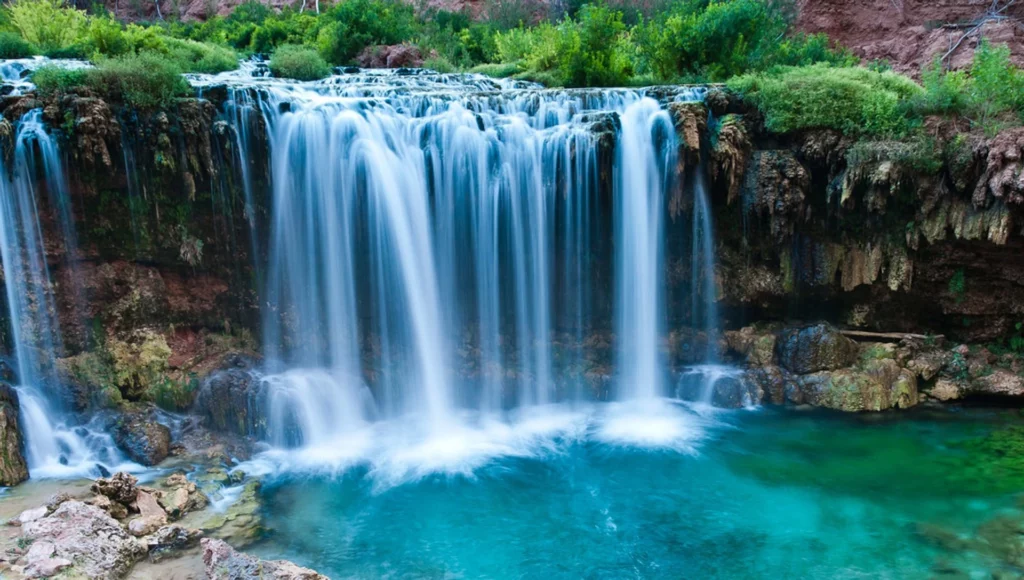
Navajo Falls has a unique history among the waterfalls of Supai. Originally one of the main attractions in the area, Navajo Falls was significantly altered by a massive flash flood in 2008. The flood reshaped the landscape, diverting the water flow and creating two new waterfalls: Upper Navajo Falls and Lower Navajo Falls.
Upper Navajo Falls is a smaller, more tranquil waterfall, while Lower Navajo Falls is more dramatic, with a larger drop and a deeper pool. The creation of these new falls has added even more variety to the already impressive array of waterfalls in Supai. Visitors can enjoy swimming and relaxing in the pools at both Upper and Lower Navajo Falls, and the area is less crowded than Havasu Falls, offering a quieter experience.
The transformation of Navajo Falls is a testament to the ever-changing nature of the Grand Canyon’s landscape. It also highlights the power of natural forces in shaping the environment, creating new beauty in the wake of destruction.
Fifty Foot Falls
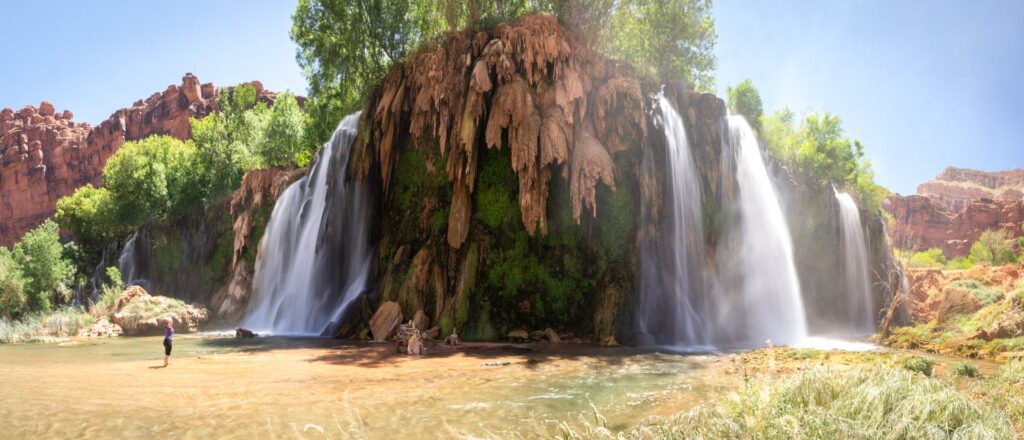
Fifty Foot Falls is one of the lesser-known waterfalls in Supai, often overlooked by visitors in favor of the more famous cascades. However, this hidden gem offers a peaceful and beautiful spot to escape the crowds and enjoy the natural beauty of the canyon.
Located just upstream from Navajo Falls, Fifty Foot Falls is named for its approximate height. The falls cascade over a wide ledge into a shallow pool, surrounded by lush vegetation and the towering walls of the canyon. The area around Fifty Foot Falls is particularly beautiful in the early morning or late afternoon when the light creates a soft, golden glow on the water and rocks.
Visitors can swim in the pool at the base of the falls or explore the surrounding area, which is filled with small caves and interesting rock formations. Fifty Foot Falls may not be as dramatic as Havasu or Mooney Falls, but its quiet beauty makes it a special place worth visiting.
The Geological Formation of the Waterfalls
The waterfalls of Supai are a product of millions of years of geological processes. The Grand Canyon, where Supai is located, was carved by the Colorado River over the course of 5 to 6 million years, exposing layers of rock that date back over 2 billion years. The specific turquoise color of the water is due to the high concentration of calcium carbonate, which is dissolved from the limestone that forms much of the canyon’s bedrock.
Over time, the combination of water erosion, sediment deposition, and tectonic activity has created the stunning waterfalls and pools that we see today. The flow of water over the limestone ledges has gradually worn away the rock, creating the dramatic drops and smooth, rounded shapes that characterize the falls.
Understanding the geological history of Supai adds another layer of appreciation for the beauty and uniqueness of this remote area. The waterfalls are not just natural wonders but also windows into the deep time of Earth’s history.
Flora and Fauna Around the Waterfalls
The area around the waterfalls of Supai is home to a rich and diverse array of plant and animal life, much of which is unique to the Grand Canyon. The lush vegetation that surrounds the waterfalls is in stark contrast to the arid desert landscape of the canyon rim, creating a micro-ecosystem that supports a variety of species.
Plants such as cottonwood trees, willows, and ferns thrive in the moist environment near the waterfalls, providing shade and habitat for wildlife. The pools and streams are home to fish, frogs, and aquatic insects, while birds such as swallows, hummingbirds, and canyon wrens are commonly seen flitting among the trees and cliffs.
The Havasupai people have a deep knowledge of the local flora and fauna, using many of the plants for medicinal and practical purposes. Conservation efforts by the tribe and environmental groups aim to preserve this delicate ecosystem and protect the biodiversity of the area.
Cultural Significance of the Waterfalls
The waterfalls of Supai hold deep cultural and spiritual significance for the Havasupai people. The name “Havasupai” itself reflects the importance of the blue-green waters, which are central to their identity and way of life. The waterfalls are not just natural wonders but sacred sites that are deeply connected to the tribe’s history, religion, and traditions.
For the Havasupai, the waterfalls are a source of life and sustenance, providing water for drinking, irrigation, and bathing. They are also places of spiritual renewal and reflection, where tribal members go to connect with their ancestors and the natural world.
Visitors to Supai are encouraged to respect the cultural significance of the waterfalls and to engage with the Havasupai people in a way that honors their traditions and preserves the sanctity of these sites.
Best Times to Visit the Waterfalls
The best time to visit the waterfalls of Supai is from late spring to early fall, when the weather is warm and the water is at its most vibrant. The summer months of June, July, and August are the most popular, but they are also the hottest, with temperatures often exceeding 100 degrees Fahrenheit. Early spring (March to May) and late fall (September to November) offer cooler temperatures and fewer crowds, making these ideal times for a visit.
Winter visits are possible but come with challenges such as colder temperatures, shorter days, and the potential for icy conditions on the trails. However, those who visit in the winter are rewarded with solitude and a unique perspective on the waterfalls, which can take on a different beauty in the winter light.
Regardless of the season, visitors should be prepared for the physical demands of the hike and the remote nature of Supai. Proper planning and respect for the environment are essential for a safe and enjoyable trip.
Safety Tips for Visiting
Visiting the waterfalls of Supai requires careful planning and adherence to safety guidelines. The remote location and challenging terrain can present risks, particularly for those who are not well-prepared. Here are some essential safety tips:
- Stay Hydrated: The hike to Supai is long and often hot, so it’s crucial to carry plenty of water and drink regularly.
- Wear Appropriate Footwear: Sturdy hiking boots with good ankle support are recommended, as the trails can be rocky and uneven.
- Be Cautious on the Trails: The descent to Mooney Falls, in particular, requires caution due to its steep and exposed sections. Take your time and use the provided chains and ladders for support.
- Respect the Environment: Pack out all trash, stay on designated trails, and avoid disturbing wildlife. The Havasupai ask that visitors respect their land and follow Leave No Trace principles.
- Check Weather Conditions: Flash floods are a potential danger in the canyon, especially during the monsoon season (July to September). Always check the weather forecast and be aware of the signs of an approaching storm.
By following these guidelines, visitors can help ensure a safe and enjoyable experience in Supai.
Permits and Regulations
Access to Supai and its waterfalls is strictly regulated by the Havasupai Tribe, and all visitors must obtain a permit before entering the area. Permits are in high demand, and reservations often need to be made months in advance, particularly for visits during the peak season.
The number of visitors is limited to help preserve the natural environment and reduce the impact on the Havasupai community. Visitors are required to pay an entrance fee, which helps fund the tribe’s conservation efforts and supports the local economy.
It’s important to respect all rules and regulations, including those related to camping, swimming, and photography. The Havasupai ask that visitors do not bring drones, alcohol, or drugs into the canyon, as these are prohibited.
Camping Near the Waterfalls
Camping near the waterfalls is one of the highlights of visiting Supai. The designated campground is located between Havasu Falls and Mooney Falls, providing easy access to both of these iconic sites. The campground is equipped with composting toilets and picnic tables, but there are no showers or potable water, so visitors must bring their own or treat the creek water.
Campsites are first-come, first-served, but there is generally plenty of space to accommodate all permit holders. The campground is shaded by cottonwood trees, providing a cool and comfortable environment even during the hottest months.
Campers should be prepared for basic conditions and pack accordingly, including a sturdy tent, sleeping bag, and cooking equipment. It’s also important to follow Leave No Trace principles, including packing out all trash and minimizing your impact on the environment.
Photography Tips for Capturing the Waterfalls
The waterfalls of Supai are a photographer’s dream, with their vibrant colors, dramatic landscapes, and ever-changing light. Here are some tips for capturing stunning images of these natural wonders:
- Use a Tripod: To capture the silky smooth effect of flowing water, use a tripod and set your camera to a slow shutter speed.
- Shoot in the Golden Hours: The best light for photography is during the early morning or late afternoon when the sun is low in the sky. This light is softer and more flattering, reducing harsh shadows and glare.
- Experiment with Angles: Try shooting from different angles and perspectives to capture the full beauty of the waterfalls. Don’t be afraid to get close to the water or explore higher vantage points.
- Include People for Scale: Including a person in your shot can help convey the scale of the waterfalls and add a human element to your images.
- Protect Your Gear: The area around the waterfalls can be wet and humid, so protect your camera and lenses with waterproof bags or covers.
With these tips, you’ll be able to capture the magic of Supai’s waterfalls and bring home memories that will last a lifetime.
Environmental Conservation Efforts
The Havasupai Tribe, in collaboration with environmental organizations, has implemented several conservation efforts to protect the waterfalls and surrounding environment. These efforts include maintaining the trails, managing visitor numbers, and educating the public about the importance of preserving this fragile ecosystem.
The tribe also works to ensure that the natural resources, particularly the water supply, are used sustainably. Visitors are encouraged to support these efforts by following all rules and guidelines, minimizing their environmental impact, and respecting the land and its inhabitants.
Conservation is an ongoing process, and the success of these efforts relies on the cooperation of everyone who visits Supai. By doing your part, you can help ensure that the waterfalls remain pristine and beautiful for future generations.
Impact of Tourism on Supai
Tourism is both a blessing and a challenge for the Havasupai people. While it provides a significant source of income and supports the local economy, it also brings pressures and challenges, including environmental degradation, overcrowding, and cultural disruption.
The Havasupai Tribe has taken steps to manage these impacts, including limiting the number of visitors, enforcing strict regulations, and engaging in continuous conservation efforts. They have also worked to educate visitors about the cultural significance of the waterfalls and the importance of respecting their traditions.
As a visitor, it’s important to be mindful of your impact and to support the tribe’s efforts by following all rules and guidelines, contributing to conservation initiatives, and treating the land and its people with respect.
Conclusion
The waterfalls of Supai, Arizona, are among the most beautiful and enchanting natural wonders in the world. From the iconic Havasu Falls to the hidden gem of Beaver Falls, each waterfall offers a unique experience that showcases the stunning beauty and rich history of the Grand Canyon. Visiting Supai is not just a journey into a remote and pristine landscape, but also an opportunity to connect with the culture and traditions of the Havasupai people.
While the journey to Supai may be challenging, the rewards are more than worth the effort. The chance to witness these magnificent waterfalls, swim in their turquoise pools, and immerse yourself in the serenity of the canyon is an experience that will stay with you for a lifetime.
Whether you’re an adventurer, a photographer, or simply a lover of nature, Supai’s waterfalls are a must-see destination that will leave you with unforgettable memories and a deep appreciation for the wonders of the natural world.
FAQs
1. What are the main waterfalls to visit in Supai, Arizona?
The main waterfalls in Supai are Havasu Falls, Mooney Falls, Beaver Falls, Navajo Falls, and Fifty Foot Falls, each offering unique beauty and experiences.
2. How difficult is the hike to reach the waterfalls?
The hike to the waterfalls is challenging, involving an 8-mile trek from Hualapai Hilltop to Supai Village, with additional hikes required to reach each waterfall. The terrain is rugged, and proper preparation is essential.
3. What is the best time of year to visit Supai?
The best time to visit is from late spring to early fall, with April to June and September to October offering the most favorable weather conditions.
4. Are permits required to visit the waterfalls in Supai?
Yes, permits are required for all visitors, and they must be obtained in advance through the Havasupai Tribe’s reservation system.
5. Can you swim in the waterfalls?
Yes, swimming is allowed in most of the pools at the base of the waterfalls, and the water is refreshingly cool and inviting.
6. How can visitors contribute to the conservation of the waterfalls?
Visitors can contribute by following all rules and regulations, practicing Leave No Trace principles, and supporting conservation efforts by the Havasupai Tribe.
Discover more from City Towner
Subscribe to get the latest posts sent to your email.

